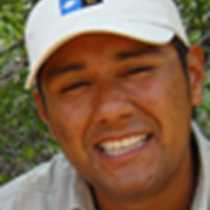Santa Cruz Island
It was very nice to see the clear sky in the northern part of Santa Cruz. When we woke, we observed a great distance between the land and National Geographic Endeavour. Our Captain Fausto Hinojosa knows by experience that safety comes first. He has worked for Lindblad Expeditions a little more than 13 years and is one of the best in the Galápagos Islands.
At 8:30am our Expedition Leader Sofia Darquea announced our excursion; with a lot of enthusiasm everyone prepared the necessary gear for this great day: Cameras, hats, water, etc.
It was great to see the activity in the middle of Canal Itabaca; a place with some ferries that serve as the only transportation service between Baltra and Santa Cruz Island, where we have several flights in the morning with people arriving and leaving the Galápagos Islands from all around the world.
The bus drivers helped us to disembark; it was getting a little warmer as the sun finally showed on the horizon illuminating some of the highest geological formations. Some of those are volcanoes well eroded by the wind, water and plants that dominate the green color during this rainy season.
The visit to the butterfly farm exceeded our expectations. Giant tortoises are the largest reptiles found in these vast green lands where food supply is ample. This is the reason why this farm decided to leave a lot of space for these great herbivores. Some of them may live to be 200 years old and weight 600 pounds; males are the largest, females are smaller with some shiny carapaces and some are recognizable at a great distance.
A few friends also spotted in the distance a rare species of bird; the Vermillion flycatcher. This is an endangered species of Santa Cruz Island because of the introduction of the Smooth Billed Ani.
The Galápagos National Park is trying to preserve a good portion of the original habitat of Scalesia plants that offer a good nesting for Darwin finches and some orchids found nowhere else in the world. For now the rain helps the land wildlife in many ways as some of the birds are reproducing faster, they need the food provided by flowers and seeds.
After spending a good amount of time here we decided to move to our next destination; Altair restaurant. Here our guests used the nice pool and enjoyed the great view for a long time. Some jogged here to spend some time looking at the farms.
Our next destination was more serious: the Charles Darwin Foundation. Their incredible research helped to preserve the Galápagos Islands in many ways. Our naturalist did their best to explain what they did years ago to investigate complex life forms and what they will do with our support.




